


The Air Force Flight
Test Center at Edwards AFB. 
NASA
Dryden Public Affairs Office 
NASA  Dryden provides Research Airplane Program Fact Sheets.
Dryden provides Research Airplane Program Fact Sheets.
Photos from several Open House displays at 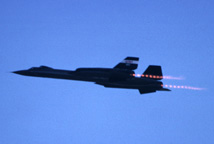 Edwards AFB.
Edwards AFB.
Link: Landsat Thematic Mapper Image of Edwards AFB |
The Mojave Ecosystem Database Program  provides a set of Landsat Thematic Mapper
images of the entire Mojave Desert, including Edwards AFB. Images of the surrounding area are also available.
provides a set of Landsat Thematic Mapper
images of the entire Mojave Desert, including Edwards AFB. Images of the surrounding area are also available.
 I have always been particularly
interested in the research planes flown at Edwards AFB in the
early years of the jet age. NASA
Dryden Flight Research Center hosts a photo archive that
features downloadable images of these aircraft.
I have always been particularly
interested in the research planes flown at Edwards AFB in the
early years of the jet age. NASA
Dryden Flight Research Center hosts a photo archive that
features downloadable images of these aircraft.
 The Air Force also hosts a photo archive at
Edwards which emphasizes contemporary test aircraft.
The Air Force also hosts a photo archive at
Edwards which emphasizes contemporary test aircraft.
Edwards AFB History: Bell X-1 Explosions |
The pictures below link to larger images stored in the NASA Dryden Photo Archive.
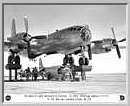 This picture is a rare photo of the third of the original XS-1 (serial 46-064) series aircraft which was called
"Queenie" being mounted under the EB-50A (serial
46-007) launch plane shortly before both aircraft were destroyed
in an explosion.
This picture is a rare photo of the third of the original XS-1 (serial 46-064) series aircraft which was called
"Queenie" being mounted under the EB-50A (serial
46-007) launch plane shortly before both aircraft were destroyed
in an explosion.
The destruction of these airplanes was nearly as disastrous to the X-1 program as the explosion of the Challenger was to the Space Shuttle program. The introduction of both programs was delayed by the development of a suitable turbopump to deliver fuel and liquid oxygen to the rocket engines. In the case of the X-1 program, a decision was made to build the first two XS-1 rocket planes with high pressure fuel systems using compressed nitrogen gas to force the fuel into the four combustion chambers of the XLR-11 rocket engine. In order to contain the pressure, the fuel tanks had to be made spherical instead of conforming to the fuselage contours, and room had to be provided for a number of spherical nitrogen source bottles. This resulted in a considerably reduced fuel volume, shorter burn time, and restricted maximum achievable speed and altitude compared to the aircraft as designed with turbopumps, but it allowed for supersonic flights to be made in 1947.
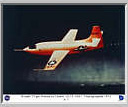 The first XS-1, Glamorous Glennis, (serial 46-062)
had been retired following its final flight (which was filmed for
the Howard Hughes film "Jet Pilot" with John Wayne) on
May 12, 1950.
The first XS-1, Glamorous Glennis, (serial 46-062)
had been retired following its final flight (which was filmed for
the Howard Hughes film "Jet Pilot" with John Wayne) on
May 12, 1950.
 The second XS-1 (serial 46-063), equipped with a
high pressure fuel system, was the only other operational XS-1.
The second XS-1 (serial 46-063), equipped with a
high pressure fuel system, was the only other operational XS-1.
It wasn't until April, 1951 that Queenie, the first X-1 to be equipped with a turbopump was delivered to Edwards AFB. The use of the turbopump to provide the pressure to force the propellants into the combustion chambers allowed for the storage of the propellants at low pressure. The tanks could be made of much thinner metal and conform to the contours of the fuselage. The amount of propellants was considerably increased over the capacity of the first two XS-1 rocket planes which translated directly to higher speeds and altitudes.
The X-1D (serial 48-1387) followed in July. The X-1D was the first of three advanced X-1 rocket planes. These had been redesigned with a longer fuselage and a more conventional stepped cockpit canopy. All were to be equipped with turbopumps and fuel tanks which conformed to the fuselage contours to maximize the available fuel.
Queenie was carried aloft under the B-29 (serial 45-21800) launch aircraft on July 20, 1951 for its first glide flight, piloted by Joe Cannon. The nose gear collpased on landing. It was not unusual for the X-1 aircraft to bounce on first contact with the ground and then stall before the wheels touched down again, resulting in a high sink rate and broken nose gear.
Four days later, the X-1D was launched by the EB-50A on July 24, 1951 for its first glide flight piloted by Bell Aircraft's Jean "Skip" Ziegler. Its nose gear also collapsed on landing.
The X-1D nose gear was repaired for a powered flight attempt on August 24, 1951 by Frank Everest. A loss of the nitrogen source pressure (used for fuel system regulators, flap actuators, and landing gear extension) resulted in a mission abort, and preparations to jettison the fuel load were begun. As the liquid oxygen tank was pressurized, it exploded. After Everest jumped into the EB-50A, the burning X-1D had to be jettisoned and was completely destroyed by explosion on impact. The actual cause of the explosion was not immediately determined, and at the time it was attributed to detonation of accumulated alcohol vapors by a radio or power supply induced spark. Queenie was the only X-1 remaining which was equipped with a turbopump.
 The
second XS-1 made a powered flight on October 23, 1951 with Joe Walker at the controls. The XLR-11 engine
cut out, truncating the fifty third flight for the aircraft. It
was not known at the time that metal fatigue would be detected in
the nitrogen source bottles for the high pressure fuel system and
result in the decision to ground the second XS-1 in late
November.
The
second XS-1 made a powered flight on October 23, 1951 with Joe Walker at the controls. The XLR-11 engine
cut out, truncating the fifty third flight for the aircraft. It
was not known at the time that metal fatigue would be detected in
the nitrogen source bottles for the high pressure fuel system and
result in the decision to ground the second XS-1 in late
November.
Queenie's nose gear was repaired by November 1951. The picture at the beginning of this essay was taken as Queenie was mounted under the EB-50A for a captive flight to test the propellant jettison system. The flight took place on November 9. Joe Cannon was prevented from jettisoning the propellants by a loss of nitrogen source pressure. After landing, the nitrogen source was repressurized, and the aircraft were towed away from the other aircraft on the flightline. As Joe Cannon, inside the cockpit of Queenie, began to pressurize the liquid oxygen tank, he heard an explosion inside the rocket plane. He jumped from the cockpit and attempted to exit the area, but subsequent explosions knocked him down and kept him pinned down until he could be pulled clear of the scene by William Means and Walter Myers of Bell Aircraft. He was badly burned, but subsequently recovered. He did not fly rockets again. Both aircraft were completely destroyed in the fire. The Air Force was left without high speed rocket research aircraft for over a year. There were no more X-1 aircraft available.
The cause of the explosion was suspected initially to have been a failure of the nitrogen "tube bundle" pressurization system, but was eventually traced to the use of ulmer leather gaskets in conjunction with liquid oxygen. Paraffin residue from the gaskets in the liquid oxygen tank provided the fuel for the explosions which were triggered by the impulse of tank pressurization. Two more aircraft and two lives were lost before this was discovered.
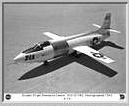 The X-1A (serial 48-1384) would not be delivered
to Edwards AFB until January 11, 1953. Its first flight was flown
on February 14 of that year and it was destroyed as the result of
an ulmer leather/liquid oxygen detonation on August 8, 1955. The
The X-1A (serial 48-1384) would not be delivered
to Edwards AFB until January 11, 1953. Its first flight was flown
on February 14 of that year and it was destroyed as the result of
an ulmer leather/liquid oxygen detonation on August 8, 1955. The 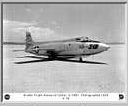 X-1B (serial 48-1385) arrived at Edwards on June
20, 1954, almost three years after the photo at the beginning of
this essay was taken.
X-1B (serial 48-1385) arrived at Edwards on June
20, 1954, almost three years after the photo at the beginning of
this essay was taken.
For the complete story of the X-1, Skystreak, Skyrocket, and X-2 programs, read Richard Hallion's Supersonic Flight, which was the source of this information. Also, NASA Dryden hosts an on line illustrated history of the flight research center entitled On the Frontier.
Send a message to Brian.
Go to home page of the Goleta Air and Space Museum.
Edited July 3, 1998.